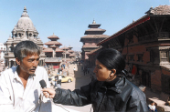Riding the radio wave: community radio in South Asia
 [caption id="attachment_2032" align="alignright" width="170" caption="Community radio"]
[caption id="attachment_2032" align="alignright" width="170" caption="Community radio"] [/caption]
[/caption]When the agrarian villagers of Budikote, a small village in Kolar district of Karnataka first heard of a community radio station, there were clueless about the difference another radio network would make to their lives. After all, there was already a multitude of radio stations beaming down from the private and government-owned channels in the district. The All India Radio streamed a host of advertisements, Bollywood songs, popular religious music and in between, some news. But soon after India’s first cable community radio station, Namma Dhwani (meaning ‘Our Voice’) was launched, the small but substantial impact on the everyday lives of the villagers were immediately visible.
UNESCO documented the impact of the Namma Dhwani Community Radio station, and described it as narrative snippets of how the villagers are leading a higher quality of life due to increased accountability of the government and a change in villagers’ attitudes. Villagers can now speak about their everyday affairs with greater assertion. With the presence of Namma Dhwani, issues such as availability of drinking water for example, have been easier to deal with in Budikote. The Namma Dhwani project documents the change -
“For about 8 days Budikote was not able to get drinking water because the pipes of the main bore well were broken. The irritated women gathered in front of the building, discussing their problems. One of Namma Dhwani’s volunteers Nagaraj, 20, borrowed the recording equipment and recorded the opinions of the women. He then played these sound bytes to the Panchayat secretary who promised to look into the matter and have it fixed in the next 2 days. Sure enough, the water was gushing by the end of the next day.”
The presence of a social media network has given voice to over 300 families who live in Budikote, now sharing and using information over radio around health, local crops, government schemes, resolving their issues in their own dialect. The community-based media center is run with the help of volunteers – trained in all aspects of radio production and broadcast – including scripting, recording and shooting, as well as the formation of listener groups in the villages. “The role of small, specific groups in each village or area is critical to the idea of community radio. This is the space where information can be ‘narrowcast’ to a specific audience, opinions and response can be measured and collective action can be taken,” pointed out Ram, a community radio practioner based in Bangalore.
Radio and the South Asian experience
Community radio is a radio service that broadcasts content which is popular to a local audience but which may be overlooked by commercial or mainstream radio. The case of the South Asian experience with community radio has been dotted with instances of ingenuity and innovation, which has enabled alternate networks of communication both in the rural hinterlands and even in congested urban spaces. In Karnataka, cable television networks are used as is the case for Namma Dhwani or recording shows locally and broadcasting them on the regional government-owned airwaves by purchasing weekly time slots by Katch Lok Ni Vaani in Gujarat.
Ever since the launch of South Asia’s first community radio station, Radio Sagarmatha, on Nepalese airwaves in May 1997, many such experimental stations have been operational in India, Nepal, Sri Lanka and Bangladesh. “When communities can own their own radio stations, you can realize local information for local needs. This is the first step towards empowerment,” explains Ashish Sen, the head of Asia-Pacific Branch of the World Association of Community Radio broadcasters, describing the role of community radio in South Asia.
There is an absence of a clearly constructed policy around community media, especially radio. Along with a gradual loosening of state control over the airwaves in the region, the community radio is emerging as an exercise in using indigenous methods to relay information. Consequently, Nepal and India have been resolving and formulating a policy structure for community airwaves based on the experiences with community radio in the last decade.
Radio Sagarmatha - NEPAL
The Nepal Forum of Environmental Journalists established the first community radio station of South Asia, Radio Sagarmatha, in the Katmandu valley in 1997. The struggle to operate Radio Sagarmatha took over half a decade. Getting a license was difficult in absence of a Nepalese community radio policy. The final license was drawn up with 17 conditions, including a blanket curb on broadcasting news and current affairs as well as refraining from taking up economic agenda in their programming. The radio station clearly defines its agenda – defending democracy and freedom of speech.
During the early 2000’s, Radio Sagarmatha played an important role in leading the Free Independent Radio Movement. In December 2005, the radio station was raided by army troops. Journalists were arrested and their equipment taken away. The crackdown was initiated by the royal regime against the radio station for broadcasting an interview of CPN-Maoist Chairman Prachanda from BBC Nepal Service.
Radio Sagarmatha broadcasts its programs in Nepalese, as well as ethnic languages of Nepal like Newari, Maithali, Tamang etc. In its 18 hours of daily broadcasting, it now has 9 news bulletins everyday. It has 90 programmes broadcast during a week, many of them on issues of public health, rule of law, education, environment, sustainable development, gender equality and women empowerment, good governance, human rights, culture and tourism folk music, youth issues amongst others.
Radio Sagarmatha has been broadcasting a popular programme to preserve the social, economic and cultural history of Nepali society, called Uhile Bajeka Palama (‘In the Time of Our Forefathers’). Senior journalist, Bhairab Risal, 81, talks to his senior guests about the social, cultural and economic situation of their time in his stylish way. The reach and popularity of Radio Sagarmatha makes it the largest community radio service in South Asia, reaching out to 2.5 million regular listeners and available across 10 million people through relays and broadcast by local community radio stations across Nepal.
Community Radio Forum - INDIA
The civil society in India was perhaps the last in the country to catch the community radio bus. Since 1995, when the Supreme Court of India ruled in a judgment that “airwaves are public property,” several educational stations, based out of university campuses started operation. It was not till November 2006 that the government of India allowed for NGO’s and other civil society organizations to operate community radio stations. In 2008, various activists and community representatives from across the country registered as the Community Radio Forum, to co-ordinate training and support for fledgling community radio units.
The criticism of the government’s community radio policy voiced periodically at the Community Radio Forum has been around the licensing procedure. Open only to NGOs registered for at least three years, this practice restricts new entrants and innovations on field. Also, the entire process of applying for a community radio license, including submissions and screenings in the capital – New Delhi, is expensive for many hinterland communities. Even post application, the processing time for a license is a year and a half for NGO’s. The information available on permitted transmitters and other technology is scanty. There are stringent restrictions for fundraising. The licensing conditions favor well-funded stations as against the low cost innovative networks. Of the 62 Grant of Permission Agreements for radio stations, issued by Ministry of Information and broadcasting at the end of 2009, most are educational institutions.
Like Nepal, India’s community radio policy also prohibits relay of news and current affairs on community based radio networks. Most activists are eager for a democratic tool like community radio to be in the hands of local village level institutions. Fredrick Noronha, an initiator of the Community Radio-India network in 2001, feels improved impetus on training is necessary to make community radio in India work. “Since this is a ‘new’ media tool for this part of the world, there is a lack of skills among most. Creating content that is interesting is not an easy job.”
Enabling Disaster Rehab -PAKISTAN
The Pakistan Press Foundation’s (PPF) response by restoring the communication networks in the region after the 2005 earthquake in North West Frontier Province and Kashmir has provided solid foundations for community radio in the country. In the aftermath of the disaster, all radio and television transmitters and antennas were destroyed. The politically volatile region, with an previous curb on mobile phones and private radio, was in middle of crisis with no effective method of communication with each other or the outside world.
At this time, PPF got together volunteers with little or no experience to write and report for radio studios constructed inside shipping containers. The impact felt in managing the disaster has encouraged a fresh whiff of enthusiasm for community radio across the country. PPF has now established 12 radio studios in 12 press clubs across Pakistan. It is hoped that these will be converted into community radio studios once the Pakistan Electronic Media Regulatory Authority licenses are granted.
Looking Ahead
While the traditional mode of radio transmission struggle with bureaucracy and political sluggishness, new technologies might change the game soon. Transmission of community-based content over the Internet is already in practice in urban pockets of South Asia. Mobile operators have also started to offer commercial broadcast services over GSM, completely bypassing government restrictions. The sustained challenge of free speech and expression sees its potential in community radio.
Reference Links:
http://portal.unesco.org/ci/en/ev.php-URL_ID=14615&URL_DO=DO_TOPIC&URL_SECTION=201.html
http://www.radiosagarmatha.org/
http://maraa.in/2009/05/a-new-vision-for-community-radio-in-india
http://en.wikipedia.org/wiki/Community_radio
http://www.youtube.com/watch?v=r7hOgHUAgeM&feature=related
http://www.ifex.org/pakistan/2010/01/27/ppf_rural_community_radio/
Photo Credit – UNESCO (Community Multimedia Centers)
Siddharth Chadha is based in Bangalore and currently associated with a research project “Towards Détente in Media Piracy” with Alternate Law Forum and Sarai-CSDS. The project is supported by the International Development Research Centre, a Canadian Crown Corporation that works in close collaboration with researchers from the developing world in their search for the means to build healthier, more equitable, and more prosperous societies.
Similar content
posted on
22 Aug 2013
from - to
06 Oct 2023 - 25 Nov 2023
deadline
01 Mar 2020
deadline
15 Sep 2017
deadline
31 Dec 2022






